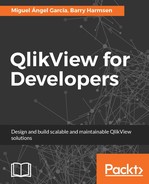Since the previous version of this book was published in 2012, the Qlik ecosystem has expanded significantly. In this chapter, we will bring you up to speed with the changes over the past few years.
If QlikView 12 is your first entry into the world of Qlik then you might be tempted to skip this chapter. However, we highly recommend that, even as a new developer you, at least read the What is new in the Qlik product portfolio? section.
We will start with a look at some of the most important changes in QlikView 12. Although QlikView 12 Desktop is the main focus of this book, we will also discuss the changes and improvements in QlikView 12 Server and Publisher.
Next, we will take a look at the broader picture and see how the Qlik product portfolio has changed in the past few years. We will learn what these new products do and how they might fit into your Qlik deployment.
Finally, as this book is itself an update, we will finish this chapter by looking at some of the changes that were made in this revised edition of QlikView for Developers.
To summarize, in this chapter we will specifically look at:
- What is new in QlikView 12?
- What is new in the Qlik product portfolio?
- How do the products in the Qlik product portfolio fit together?
- What is new in QlikView 12 for developers?
Apart from a restyled application icon, at first glance QlikView 12 looks remarkably similar to its predecessor. Under the hood, however, many improvements and fixes have been realized, and in this section we will take a high level view at some of those changes.
The main difference compared to previous versions is that the underlying engine of QlikView has been replaced with the updated QIX Engine 2.0. This is the same engine that powers the other products in the Qlik portfolio (Qlik Sense Enterprise and the Qlik Analytics Platform, discussed later). Besides performance improvements over the previous version, this common engine makes it easier to share data models between QlikView and the other Qlik products, notably Qlik Sense. The shared code base of the engine also ensures that future investments that Qlik does in features, performance, security, and connectivity can be easily back ported to QlikView.
Where previously there were both 32-bit and 64-bit versions of the QlikView software, QlikView 12 desktop and server are only available in the 64-bit version. Since the publication of the previous version of this book was in 2012, 64-bit versions of Windows on the desktop have become commonplace (64-bit was already the norm on servers). The 32-bit QlikView desktop version, with its memory limited to 2 GB, has become outdated. If you have a hard requirement to still use a 32-bit version of the software, you will need to fall back to QlikView 11.2.
QlikView 11.2 and earlier included local documentation and help files. With QlikView 12 all documentation and help is found online.
For the English version of QlikView, which we will use in this book, the online help can be found at:
You will notice that only the version number is different in the URL.
Downloadable guides can also be found in the online documentation:
The next changes mainly impact the server side of QlikView, but they are still interesting to take note of.
Although not visible from the outside, Qlik has made significant investments in security around QlikView 12. Improvements include stronger encryption and better encryption handling, centralized client request handling, and XML parsing. These improvements mean that QlikView can now meet some of the more demanding security requirements within the private sector, government, and military.
With QlikView 12, all the functions that are available in the regular QlikView web client are also accessible on touch devices. Besides consuming applications, this means that you can now also use collaboration capabilities, create and modify objects, and export to Excel on a mobile device. You can also use swiping to scroll, or use a long-press to activate the right-click menus.
QlikView 12 supports more nodes in a clustered environment, which means that in multi-node environments QlikView will be able to support more concurrent users.
In QlikView 12.1, released in November 2016, even more improvements have been made in the area of clustering, allowing QlikView to scale to even more nodes, users, and documents.
Changes in QlikView 12.1 include improvements for dealing with high-load scenarios, such as shared file caching, offline mode for PGO files, better caching in AccessPoint, and more efficient communication between services.
QlikView 12.1 also has the option to use unbalanced nodes in a cluster (that is, using servers with differences in CPU and RAM in the same cluster). For Publisher, it is now possible to create multiple Publisher (QDS) clusters, referred to as Publisher groups, and to assigns tasks to specific nodes within a cluster.
